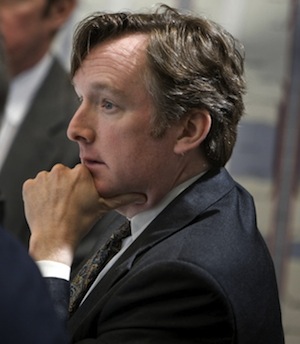
City sustainability chief David Bragdon offered some more hints about what to expect from April's update of PlaNYC this morning. Speaking at a livability conference hosted by NYU's Rudin Center, Bragdon said that the update would eschew large capital projects and feature a larger role for neighborhoods and individuals. In terms of transportation, Bragdon seemed to suggest that a call for a new Hudson River crossing of some kind would be a part of PlaNYC 2.0.
Much of what Bragdon had to say about the PlaNYC update has already been revealed: That the plan will take on solid waste management, for example, or that the administration wants to allow street hails for livery vehicles.
But he did suggest one idea sure to inspire fierce controversy. "We will be proposing to charge people ten dollars," said Bragdon, pausing for effect, "if they want to have a hard copy of PlaNYC."
When Bragdon turned more seriously to transportation policy, he offered an intriguing discussion about New York's connections to the west. Bragdon pointed out that the number of rail crossings underneath the Hudson River, two, hasn't changed in a century, though in that time the population of New Jersey has tripled while that of New York City has doubled. "We're still making do with what we have here," he said, but "doing nothing has a high cost."
With that kind of talk, it seems that some sort of post-ARC proposal to add rail capacity underneath the Hudson will be in PlaNYC 2.0. Perhaps the return of the Secaucus 7?
In large part, Bragdon focused on the update's new approach rather than new policies. With the city grappling with the recession's fiscal fallout, he said, there won't be any major new capital commitments in the update. Outlays like the $134 million for public plazas, he said, will be maintained but not likely to be repeated. How that commitment could be squared with the goal of new capacity across the Hudson isn't clear.
Perhaps because of those fiscal constraints, Bragdon said that the update wouldn't exclusively be made up of city programs, but would seek to enlist both local community groups and individuals. "A greater and greener New York is made up of greater and greener neighborhoods," he said. That shift is already underway in the Department of Environmental Protection's announcement yesterday of a competitive grant program that would fund local businesses and non-profits trying to build their own green infrastructure projects.
Finally, Bragdon said that the new PlaNYC would expand the sustainability focus from being about "pure utility for human beings" to include "nature for the sake of nature." In addition to asking how to fit one million new people in New York City, he said, it would also ask "how many alewife herrings do we want coming back to the Bronx River?"
During his remarks, Bragdon also warned New Yorkers not to over-learn from Portland. The city is far newer, smaller, and more homogeneous than New York. In fact, at 580,000 people, Portland is only as populated as Manhattan was in 1850.
Bragdon did think it important, however, that Portland and New York City were two of the first cities to trade in federal highway dollars for transit. In Portland, they used the money slated for the Mt. Hood freeway, which would have destroyed one percent of the city, to build the first pieces of the city's light rail system.
New York City, argued Bragdon, saved its transit system by cashing in Westway. Every time you travel on a clean and reliable subway, said Bragdon, "You need to be able to connect the dots on that experience we have every day to the $1.5B dollars, in 1985 dollars, to Mayor Koch and Governor Cuomo coming around and cancelling Westway."





